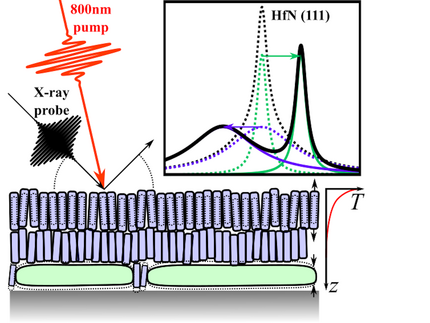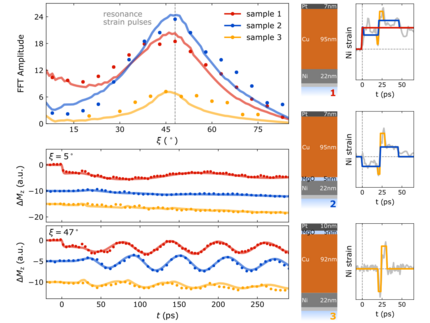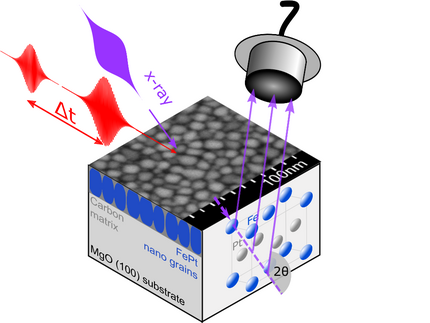Ultrafast lattice dynamics
The group has substantial experience in analyzing the ultrafast response of crystalline thin films and nanostructures to laser excitation. Although the ultrafast motion associated with optical phonons is encoded in the intensity oscillations of x-ray diffraction signals, we emphasize the analysis of the transient strain via shifts and shape variations of the Bragg reflections. As a related technique, we have developed a broadband time-domain Brillouin scattering approach. This research direction is embedded in the community of scientists studying picosecond ultrasonics and surface acoustic waves. The control of ultrafast acoustics is highly relevant for, e.g., controling ultrafast magnetism. A special focus of the research on lattice dynamics lies on the propagation of strain wave packets, which may exhibit nonlinear phenomena such as second harmonic generation of phonons as analogs of nonlinear optics for light fields. The anharmonicity that governs nonlinear propagation is also relevant for thermal expansion and thermal transport. A very recent direction is the inversion of strain waves via ultrafast contractive stresses, which are typically induced by entropy changes of the spins or a subset of phonons, as predicted by negative thermal expansion (NTE) in equilibrium. We have studied various metallic and semiconducting systems with an emphasis on oxides.
Related publications
S. P. Zeuschner, J.-E. Pudell, M. Mattern, M. Rössle, M. Herzog, A. Baldi, S.H. C. Askes, M. Bargheer
Unveiling the Nanomorphology of HfN thin Films by Ultrafast Reciprocal Space Mapping
Advanced Optical Materials 12, 2400939 (2024).
Hafnium Nitride (HfN) is a promising and very robust alternative to gold for applications of nanoscale metals. Details of the nanomorphology related to variations in strain states and optical properties can be crucial for applications in nanophotonics and plasmon-assisted chemistry. Ultrafast reciprocal space mapping (URSM) with hard X-rays is used to unveil the nanomorphology of thin HfN films. Static high-resolution X-ray diffraction reveals a twofold composition of the thin films being separated into regions with identical lattice constant and similar out-of-plane but hugely different in-plane coherence lengths. URSM upon femtosecond laser excitation reveals different transient strain dynamics for the two respective Bragg peak components. This unambiguously locates the longer in-plane coherence length in the first 15 nm of the thin film adjacent to the substrate. The transient shift of the broad diffraction peak displays the strain dynamics of the entire film, implying that the near-substrate region hosts nanocrystallites with small and large coherence length, whereas the upper part of the film grows in small columnar grains. The results illustrate that URSM is a suitable technique for non-destructive and depth-resolved investigations of the morphology of nanostructures.
Jarecki J., Mattern M., Weber F.-C., Pudell J.-E., Wang X.-G., Rojas-Sánchez J.-C., Hehn M., von Reppert A., and Bargheer M.
Controlling effective field contributions to laser-induced magnetization precession by heterostructure design
Communications Physics 7, 12 (2024).
Nanoscale heterostructure design can control laser-induced heat dissipation and strain propagation, as well as their efficiency for driving magnetization precession. Here, we incorporate MgO layers into the experimental platform of metallic Pt-Cu-Ni heterostructures to block the propagation of hot electrons. We show via ultrafast x-ray diffraction the capability of our platform to control the spatio-temporal shape of the transient heat and strain. Time-resolved magneto-optical Kerr experiments with systematic tuning of the magnetization precession frequency showcase control of the magnetization dynamics in the Ni layer. Our experimental analysis highlights the role of quasi-static strain as a driver of precession when the magnetic material is rapidly heated via electrons. The effective magnetic field change originating from demagnetization partially compensates the change induced by quasi-static strain. The strain pulses can be shaped via the nanoscale heterostructure design to efficiently drive the precession, paving the way for opto-magneto-acoustic devices with low heat energy deposited in the magnetic layer.
Mattern M., von Reppert A., Zeuschner S. P., Herzog M., Pudell J.-E., and Bargheer M.
Concepts and use cases for picosecond ultrasonics with x-rays
Photoacoustics 31, 100503 (2023).
This review discusses picosecond ultrasonics experiments using ultrashort hard x-ray probe pulses to extract the transient strain response of laser-excited nanoscopic structures from Bragg-peak shifts. This method provides direct, layer-specific, and quantitative information on the picosecond strain response for structures down to few-nm thickness. We model the transient strain using the elastic wave equation and express the driving stress using Grüneisen parameters stating that the laser-induced stress is proportional to energy density changes in the microscopic subsystems of the solid, i.e., electrons, phonons and spins. The laser-driven strain response can thus serve as an ultrafast proxy for local energy-density and temperature changes, but we emphasize the importance of the nanoscale morphology for an accurate interpretation due to the Poisson effect. The presented experimental use cases encompass ultrathin and opaque metal-heterostructures, continuous and granular nanolayers as well as negative thermal expansion materials, that each pose a challenge to established all-optical techniques.
This publication is part of the Special Issue Ultrafast Photoacoustics.
Rongione E., Gueckstock O., Mattern M.,Gomonay O., Meer H., Schmitt C., Ramos R., Kikkawa T., Mičica M., Saitoh E., Sonova J., Jaffrès H., Mangeney J., Goennenwein S.T.B., Geprägs S., Kampfrath T., Kläui M., Bargheer M., Seifert T.S., Dhillon S., and Lebrun R.
Emission of coherent THz magnons in an antiferromagnetic insulator triggered by ultrafast spin–phonon interactions
Nature Communications 14, Article number: 1818 (2023)
Antiferromagnetic materials have been proposed as new types of narrowband THz spintronic devices owing to their ultrafast spin dynamics. Manipulating coherently their spin dynamics, however, remains a key challenge that is envisioned to be accomplished by spin-orbit torques or direct optical excitations. Here, we demonstrate the combined generation of broadband THz (incoherent) magnons and narrowband (coherent) magnons at 1 THz in low damping thin films of NiO/Pt. We evidence, experimentally and through modeling, two excitation processes of spin dynamics in NiO: an off-resonant instantaneous optical spin torque in (111) oriented films and a strain-wave-induced THz torque induced by ultrafast Pt excitation in (001) oriented films. Both phenomena lead to the emission of a THz signal through the inverse spin Hall effect in the adjacent heavy metal layer. We unravel the characteristic timescales of the two excitation processes found to be < 50 fs and > 300 fs, respectively, and thus open new routes towards the development of fast opto-spintronic devices based on antiferromagnetic materials.
Mattern M., Pudell J.-E., Dumesnil K., von Reppert A., and Bargheer M.
Towards shaping picosecond strain pulses via magnetostrictive transducers
Photoacoustics 30, 100463 (2023).
Using time-resolved x-ray diffraction, we demonstrate the manipulation of the picosecond strain response of a metallic heterostructure consisting of a dysprosium (Dy) transducer and a niobium (Nb) detection layer by an external magnetic field. We utilize the first-order ferromagnetic–antiferromagnetic phase transition of the Dy layer, which provides an additional large contractive stress upon laser excitation compared to its zero-field response. This enhances the laser-induced contraction of the transducer and changes the shape of the picosecond strain pulses driven in Dy and detected within the buried Nb layer. Based on our experiment with rare-earth metals we discuss required properties for functional transducers, which may allow for novel field-control of the emitted picosecond strain pulses.
Zeuschner S. P., Wang X.-G., Deb M., Popova E., Malinowski G., Hehn M., Keller N., Berakdar J., and Bargheer M.
Standing spin wave excitation in Bi:YIG films via temperature-induced anisotropy changes and magneto-elastic coupling
Physical Review B 106, 134401 (2022).
Based on micromagnetic simulations and experimental observations of the magnetization and lattice dynamics after the direct optical excitation of the magnetic insulator Bi : YIG or indirect excitation via an optically opaque Pt/Cu double layer, we disentangle the dynamical effects of magnetic anisotropy and magneto-elastic coupling. The strain and temperature of the lattice are quantified via modeling ultrafast x-ray diffraction data. Measurements of the time-resolved magneto-optical Kerr effect agree well with the magnetization dynamics simulated according to the excitation via two mechanisms: the magneto-elastic coupling to the experimentally verified strain dynamics and the ultrafast temperature-induced transient change in the magnetic anisotropy. The numerical modeling proves that, for direct excitation, both mechanisms drive the fundamental mode with opposite phase. The relative ratio of standing spin wave amplitudes of higher-order modes indicates that both mechanisms are substantially active.
Herzog M., von Reppert A., Pudell J.-E., Henkel C., Kronseder M., Back C. H., Maznev A., and Bargheer M.
Phonon-dominated energy transport in purely metallic heterostructures
Advanced Functional Materials 32, 2206179 (2022).
We use ultrafast x-ray diffraction to quantify the transport of energy in laser-excited nanoscale Au/Ni bilayers. Electron transport and efficient electron-phonon coupling in Ni convert the laser-deposited energy in the conduction electrons within a few picoseconds into a strong non-equilibrium between hot Ni and cold Au phonons at the bilayer interface. Modeling of the subsequent equilibration dynamics within various two-temperature models confirms that for ultrathin Au films the thermal transport is dominated by phonons instead of conduction electrons because of the weak electron-phonon coupling in Au.
Shayduk R., Hallmann J., Rodriguez-Fernandez A., Scholz M., Lu W., Bosenberg U., Möller J., Zozulya A., Jiang M., Wegner U., Secareanu R.-C., Palmer G., Emons M., Lederer M., Volkov S., Lindfors-Vrejoiu I., Schick D., Herzog M., Bargheer M., and Madsen A.
Femtosecond X-ray diffraction study of multi-THz coherent phonons in SrTiO3
Applied Physics Letters 120, 202203 (2022).
We report generation of ultra-broadband longitudinal coherent acoustic phonon wavepackets in SrTiO3 (STO) with frequency components extending throughout the entire first Brillouin zone. The wavepackets are efficiently generated in STO using femtosecond infrared laser excitation of an atomically flat 1.6 nm-thick epitaxial SrRuO3 film. We use femtosecond x-ray diffraction at the European X-ray Free Electron Laser Facility to study the dispersion and damping of phonon wavepackets. The experimentally determined damping constants for the multi-THz frequency phonons compare favorably to the extrapolation of a simple ultrasound damping model over several orders of magnitude.
Mattern M., Pudell J.-E., Laskin G., von Reppert A., and Bargheer M.
Analysis of the temperature- and fluence-dependent magnetic stress in laser-excited SrRuO3
Structural Dynamics 8, 024302 (2021).
We use ultrafast x-ray diffraction to investigate the effect of expansive phononic and contractive magnetic stress driving the picosecond strain response of a metallic perovskite SrRuO3 thin film upon femtosecond laser excitation. We exemplify how the anisotropic bulk equilibrium thermal expansion can be used to predict the response of the thin film to ultrafast deposition of energy. It is key to consider that the laterally homogeneous laser excitation changes the strain response compared to the near-equilibrium thermal expansion because the balanced in-plane stresses suppress the Poisson stress on the picosecond timescale. We find a very large negative Grüneisen constant describing the large contractive stress imposed by a small amount of energy in the spin system. The temperature and fluence dependence of the strain response for a double-pulse excitation scheme demonstrates the saturation of the magnetic stress in the high-fluence regime.
Deb M., Popova E., Zeuschner S. P., Leitenberger W., Keller N., Rössle M., and Bargheer M.
Ultrafast control of lattice strain via magnetic circular dichroism
Physical Review B 103, 064301 (2021).
Using ultrafast x-ray diffraction, we directly monitor the lattice dynamics induced by femtosecond laser pulses in nanoscale thin films of bismuth iron garnet in external magnetic fields H_ext . We control the ultrafast laserinduced lattice strain amplitude by changing the laser pulse helicity. The strength of H_ext is used as an external parameter to switch the helicity dependence on and off, respectively. Based on magneto-optical spectroscopic measurements, we explain these phenomena by magnetic circular dichroism. Our findings highlight an important approach for ultrafast manipulation of lattice strain in magnetic materials, in particular insulators, and open exciting perspectives towards ultrafast control of lattice strain and heat-induced magnetization switching and spin waves in bismuth-substituted iron garnets using the polarization of light.
Schmidt D., Bauer R., Chung S., Novikov D., Sander M., Pudell J.-E., Herzog M., Pfuetzenreuter D., Schwarzkopf J., Chernikov R., and Gaal P.
A new concept for temporal gating of synchrotron X-ray pulses
Journal of Synchrotron Radiation 28 (2021).
A new concept for temporal gating of synchrotron X-ray pulses based on laser-induced thermal transient gratings is presented. First experimental tests of the concept yield a diffraction efficiency of 0.18%; however, the calculations indicate a theoretical efficiency and contrast of >30% and 10^(−5), respectively. The full efficiency of the pulse picker has not been reached yet due to a long-range thermal deformation of the sample after absorption of the excitation laser. This method can be implemented in a broad spectral range (100 eV to 20 keV) and is only minimally invasive to an existing setup.
Deb M., Popova E., Zeuschner S. P., Hehn M., Keller N., Mangin S., Malinowski G., and Bargheer M.
Generation of spin waves via spin-phonon interaction in a buried dielectric thin film
Physical Review B 103, 024411 (2021).
In this paper, we investigate the magnetic, optical, and lattice responses of a Pt/Cu/Bi1Y2Fe5O12/Gd3Ga5O12 heterostructure to femtosecond laser excitation of the opaque Pt/Cu metallic bilayer. The electronic excitation generates coherent and incoherent phonons, which trigger high-frequency standing spin waves (SWs) in the dielectric Bi1Y2Fe5O12 layer via a phonon-induced change of magnetic anisotropy. We find that the incoherent phonons (heat) can induce a fast (<1ps) and slow (>1000ps) decrease of the magnetic order by different spin-phonon interaction scenarios. These results open perspectives for generating high-frequency SWs in buried magnetic garnets.
Reppert A. v., Willig L., Pudell J.-E., Zeuschner S. P., Sellge G., Ganss F., Hellwig O., Arregi J. A., Uhlíř V., Crut A., and Bargheer M.
Spin stress contribution to the lattice dynamics of FePt
Science Advances 6, eaba1142 (2020)
Invar-behavior occurring in many magnetic materials has long been of interest to materials science. Here, we show not only invar behavior of a continuous film of FePt but also even negative thermal expansion of FePt nanograins upon equilibrium heating. Yet, both samples exhibit pronounced transient expansion upon laser heating in femtosecond x-ray diffraction experiments. We show that the granular microstructure is essential to support the contractive out-of-plane stresses originating from in-plane expansion via the Poisson effect that add to the uniaxial contractive stress driven by spin disorder. We prove the spin contribution by saturating the magnetic excitations with a first laser pulse and then detecting the purely expansive response to a second pulse. The contractive spin stress is reestablished on the same 100-ps time scale that we observe for the recovery of the ferromagnetic order. Finite-element modeling of the mechanical response of FePt nanosystems confirms the morphology dependence of the dynamics.
Reppert A. v., Matter M., Pudell J.-E., Zeuschner S. P., Dumesnil K., and Bargheer M.
Unconventional picosecond strain pulses resulting from the saturation of magnetic stress within a photoexcited rare earth layer
Structural Dynamics 7, 024303 (2020).
Optical excitation of spin-ordered rare earth metals triggers a complex response of the crystal lattice since expansive stresses from electron and phonon excitations compete with a contractive stress induced by spin disorder. Using ultrafast x-ray diffraction experiments, we study the layer specific strain response of a dysprosium film within a metallic heterostructure upon femtosecond laser-excitation. The elastic and diffusive transport of energy to an adjacent, non-excited detection layer clearly separates the contributions of strain pulses and thermal excitations in the time domain. We find that energy transfer processes to magnetic excitations significantly modify the observed conventional bipolar strain wave into a unipolar pulse. By modeling the spin system as a saturable energy reservoir that generates substantial contractive stress on ultrafast timescales, we can reproduce the observed strain response and estimate the time- and space-dependent magnetic stress. The saturation of the magnetic stress contribution yields a non-monotonous total stress within the nanolayer, which leads to unconventional picosecond strain pulses.















